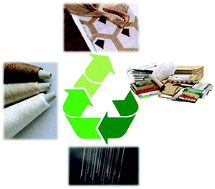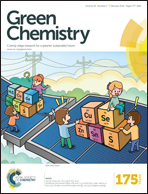Upcycling of waste paper and cardboard to textiles†
Abstract
In continuation of previously reported results, the ionic liquid 1,5-diazabicyclo[4.3.0]non-5-ene-1-ium acetate was also found to be a powerful non-derivatizing solvent for cellulosic waste such as paper and cardboard. The ionic liquid could dissolve all the present bio-polymers (cellulose, hemicellulose, and lignin) in high concentrations, resulting in solutions with visco-elastic properties that were suitable for dry-jet wet fiber spinning. The cellulosic raw materials were refined gradually to identify the influence of residual components on the spinnability of the respective solution. Polymer degradation and losses in the spinning process could be avoided nearly entirely. With the exception of virtually unrefined cardboard, all the samples showed excellent spinnability, resulting in fibers with high tensile strength. Prototype textiles were produced to validate the quality of the fibers and demonstrate the possibility of using residual lignin in cardboard as a natural dye.


 Please wait while we load your content...
Please wait while we load your content...